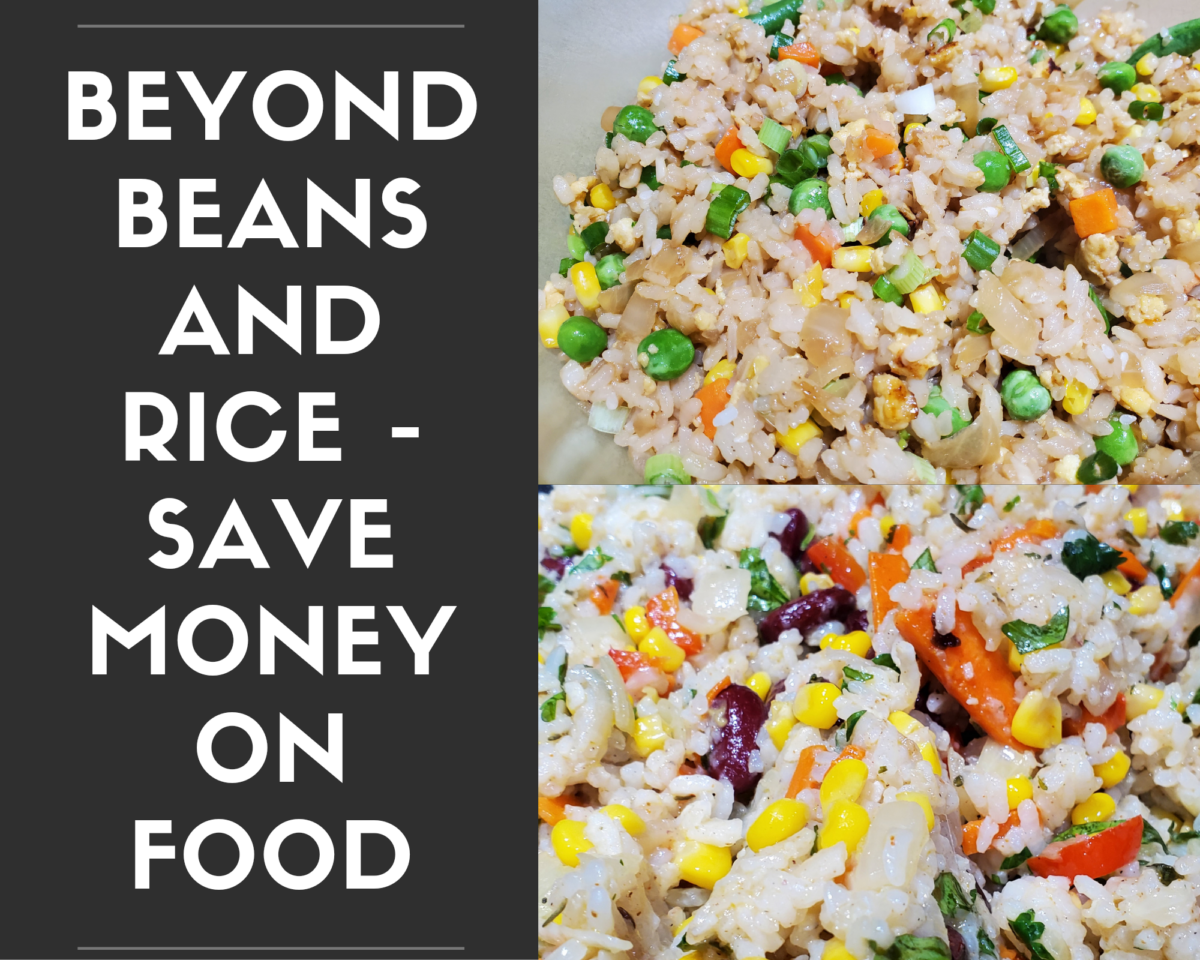Many of us focus on budgeting and paying off debt at the beginning of the year. I am a Dave Ramsey fan and have worked his plan for many years. It is a very good plan , and although I did not follow every step exactly as he presents them in his book The Total Money Makeover, I have successfully become debt free. This article is not intended to help you become debt free, just to help you save money on one of your biggest expenses, groceries. Dave pushes for a diet of beans and rice while working his plan. I’m pretty sure he does not mean that you literally have to live on beans and rice alone. Beans and rice are both inexpensive foods that can really stretch a meal. In other words, fill you up for less money. There are plenty of other inexpensive foods that can stretch a meal and other ways to save money on groceries.
Disclaimer: This post may contain affiliate links. I earn commission from qualified purchases at no additional cost to you.
Save money by wasting less
Food waste can be a huge drain on your grocery budget. A study published by the American Journal of Agricultural Economics found that the average American household wastes 31.9% of the food it buys. This works out to be over $150 of wasted food per month per household on average. If you feel you may be wasting too much food it’s definitely worth taking a look at some strategies to help you stop the waste.
How can you reduce household food waste?
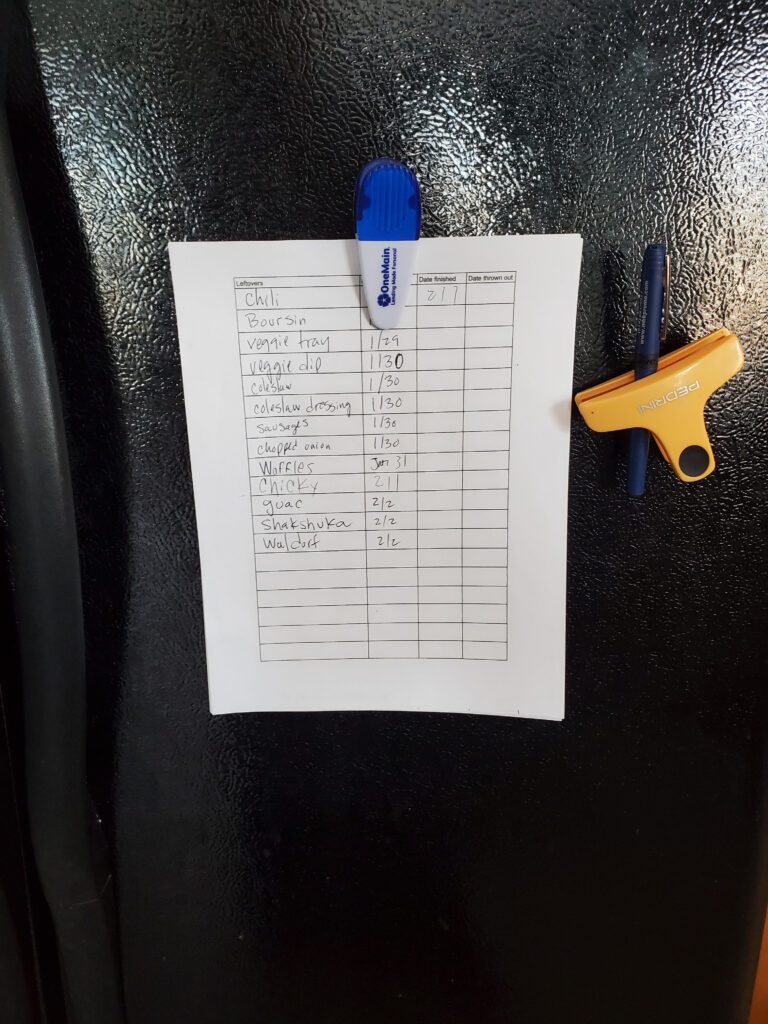
- Use your leftovers! Here is how to save money on groceries. We recently started a list of leftover food on the refrigerator door. We told the kids if we end up throwing away any leftovers we will not be able to get take out for 2 weeks. Using this system we have not thrown away any leftovers in 4 weeks! Download my leftover list below.
- Use up your produce. Unfortunately those produce drawers have a way of hiding your fruits and veggies. Out of sight out of mind. I like to keep a few fruits on the counter in a fruit bowl. Most fruits can be kept at room temperature for a few days. If they are in the bowl, they are more likely to be eaten. I also cut up a tray of fruit and leave it on the counter each weekend. It really disappears fast this way. Smoothies are another great way to use up produce quickly. Make sure you have a plan for the produce you buy. Dig through those produce drawers often and make sure you rotate stock.
- Use your freezer. Use this chart from foodsaftey.gov for guidelines on how long your food will be safe to eat. Note that the freezer recommendations are for quality only, the site explains that food can be store indefinitely at 0 degrees F or less. So don’t start throwing out food in your freezer based on that chart. If you do not think you will be able to finish a food fast enough, then freeze it if possible.
Save by making things instead of buying premade items:
Hummus is easy to make at home. It is less expensive than the premade product and is so simple especially if you have a mini food processor.
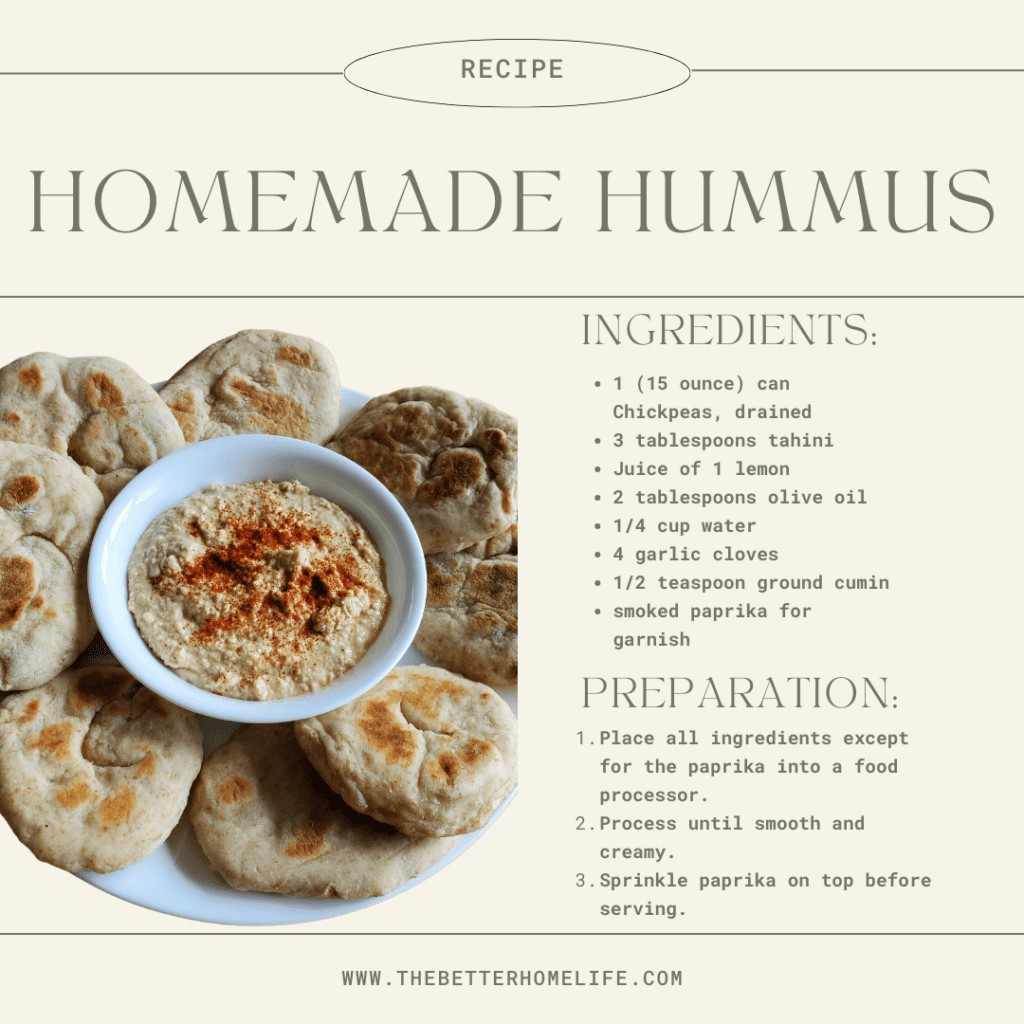
Make your own foaming hand soap. Just mix hand soap with water to get a lot more soap! All you need is a foaming soap dispenser.

Save money by packing your Lunch.
How much can you save by packing your own lunch?
Packing your lunch can be a huge cost savings over buying lunch every day. Only you can determine your actual savings. There are savings estimates out there, but it really depends on what you personally have been spending. You should be able to prepare a meal at home for less than half of the cost of the same meal as take out. For example if you buy a taco salad at a restaurant for $10.00, you could make that same salad at home for less than $5.00. Even if you could manage to save just $5.00 per day, that would be a savings of $25.00 per work week or $1300.00 per year.
Don’t just take your lunch for a ride either. You have to eat what you packed, resist the temptation to order out with your co-workers or choose that favorite dish at the cafeteria. If you end up ordering out and taking your lunch home, you may end up having to waste what you packed. Then you will have paid for 2 lunches!
How do you find the time to pack your lunch?
Make sure you pack your lunch the night before. If you save this task for the morning you will inevitably be running late. If you have children any number of things could distract you from your lunch making task, a forgotten homework assignment, a spill you have to help clean up, a lost shoe, or you name it. Trust me, if you want to save money you need to make your lunch the night before. Teach your kids to do the same.
Why should you pack your kids lunch?
I know what you are thinking. Why would I pack my kids lunch? The school lunch is only $3.00/day. Sure it would be difficult but not impossible to pack a lunch or less that $3.00/day, so why do it?
- It teaches responsibility. Kids can learn valuable skills by packing their own lunch. How to make a sandwich or salad. Knife skills for chopping fruit. Even how to add items to a grocery list when they are getting low.
- It’s healthier. I know Michelle Obama tried really hard to make school lunches healthier, but they could still use some work. Currently these lunches are free for all and my kids are still packing their lunches at home. My son tolerated the low quality tasteless food the longest. He finally gave up and started packing his own lunch after reading the ingredients on the Uncrustable in his school lunch. He said “It had too much added sugar and 50% of my daily fat. I just can’t continue to eat that food.”
- You will waste less food. Leftover dinners make great lunches. We try to use up our leftovers within 4 days. It really helps if every family member helps. If you end up throwing out leftovers because you bought that bargain $3 lunch, you have not saved anything.
- You can save money by buying in bulk. It’s easier to buy in bulk if your whole family is packing lunches. Once you open a bulk package of lunchmeat, you should use it up in 3-5 days. If only 1 or 2 people are packing sandwiches, you may end up throwing some of it out.
What should you pack for lunch?
- Soup or chili. I like to make a big pot of homemade soup or chili every week. Find my favorite soup recipe here. This is a quick and easy chili that makes great leftovers. I use a Corningware meal mug for packing soups. When my kids were younger I always packed their soups in a Thermos Funtainer. We would heat them up in the morning and the soup was still warm at lunch time. This way they could skip the microwave line and had more time to eat.
- Leftover Dinner. You have to pack up your leftovers anyway, why not just pack them for lunch. Casseroles and pasta make great leftovers for lunches.
- Salads. You can really get creative with salads. Try pasta salad, coleslaw, bean salad, Waldorf salad, or just a traditional lettuce salad. Check out my article about quick and easy packable salads.
- Sandwiches. Meat and cheese, PB &J, leftover pulled pork, leftover meatloaf. Have some fun! Get creative.
- Try Bento Box lunches. These containers are an excellent alternative to packing everything in Ziplock bags. You will save on plastic bags and benefit the environment while saving money on your food budget. Check out my bento boxed lunch post for some great ideas for kids and adults.
Save money by shopping sales
How do I find time to save?
I know you are probably thinking you don’t have time to shop several stores to get the best prices. I’d like to say that you probably do. Sales are a great way to save money on groceries. There have to be some high use non perishable items in your home. Maybe a particular sauce, or salad dressing. These are the items you want to find the best prices on. For example, I always buy Smuckers natural peanut butter at Walmart. It’s cheaper there than sale prices anywhere else. I don’t stop there every week, I just stop in and buy 3-4 jars when we are getting low. Just a few trips a year. Take the time to find the best deals on you highest use items, this will be worth your time.
Never pay full price.
I never pay full price for pasta, canned soup, BBQ sauce, mayo or any food with a long shelf life. When I grocery shop weekly, I’m mostly there to pick up fresh produce, eggs, and dairy items like milk and yogurt. I only buy meat if it is a really good sale, otherwise I defrost some meat I bought on sale earlier. Lastly, I always pick up a few nonperishable sale items for later use.

By the way, the week of the Super Bowl is a great time to stock up on chicken breast. Chicken wings are so popular for the game that the rest of the chicken parts are usually marked down for quick sale.
Why coupons are not so great
You were probably expecting an article on saving money on your grocery budget to include a bunch of ways to save with coupons. I’m not saying that I never use coupons or that they will never save you money. I’m just saying that in my experience they have not really been worth the time. It takes a lot of time to search for, clip and sort coupons. Then to keep track of expiration dates. I believe that time could be better spent saving money in other ways like meal prep or managing leftovers.
Most of the time when searching for grocery coupons they tend to be for name brand products I don’t buy. It’s much cheaper to purchase generic items. One study showed that most grocery coupons were for unhealthy food.
There is nothing worse than spending your time clipping a coupon, finding the product in the store, only to find that the store brand equivalent is less expensive than the brand name product even with the coupon. Overall I don’t believe clipping coupons is the best way to save money on groceries, and defiantly not a great way to make healthy choices.
Save money by planning your meals
Meal planning seems like a daunting task, but it’s not. Start by checking the grocery store ad for produce sales. Sales are a great way to save money on groceries. I always start my plans with what ever produce is on sale. If there is a big sale on mushrooms, I’ll plan to make my favorite recipe with mushrooms. Big sale on broccoli and cauliflower, then stir fry will be a great choice. A sale on bell peppers would be a great time for stuffed peppers.
Meal planning is not just about shopping the sales it’s about finding the time to prepare the food. If you know you will be too busy to make dinner on Wednesday night due to soccer practice, then plan that to be a leftover night. There is nothing worse than having a house full of hungry family members and no plan for dinner. These are the nights that will cost you a lot because you will cave under the pressure and order take out. There goes your food budget! Save money on groceries by making the meals on your less busy days. Make sure you defrost your meat, you might even be able to trim the meat ahead of time. Chop a few onions on the weekend, you can use them in recipes and on sandwiches and salads throughout the week.
Save with grocery apps or manager specials.
Save money on groceries by using the Flashfood app to get great deals on marked down produce and meat that is close to expiration. These items can be used right away of frozen for future use, either way the savings is usually at least 50%. Use the referral code KRIS4BP8W to save $5 on your first purchase of $10 or more.
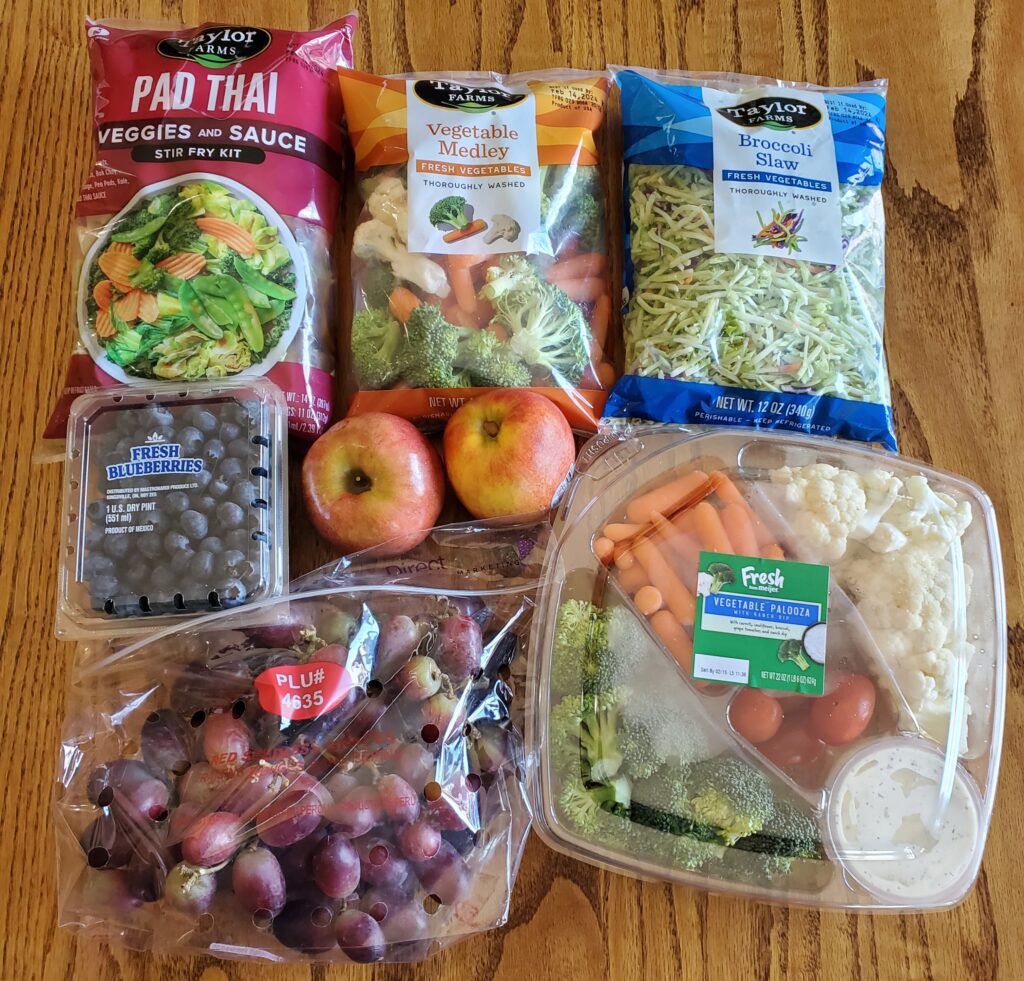
If you are driving home from an evening event, stop in any grocery store on your way home. Managers begin to mark down items with a sell by date of the following day within a few hours of closing. You can often find great Manager Specials on meat and deli items that are close to expiration. If you don’t know where to find the manager specials, ask an employee. You’ll be glad you did! If you can’t use the meat before expiration, toss it in the freezer when you get home. Pull it out for an inexpensive meal later!

How to stretch your grocery budget with low cost foods
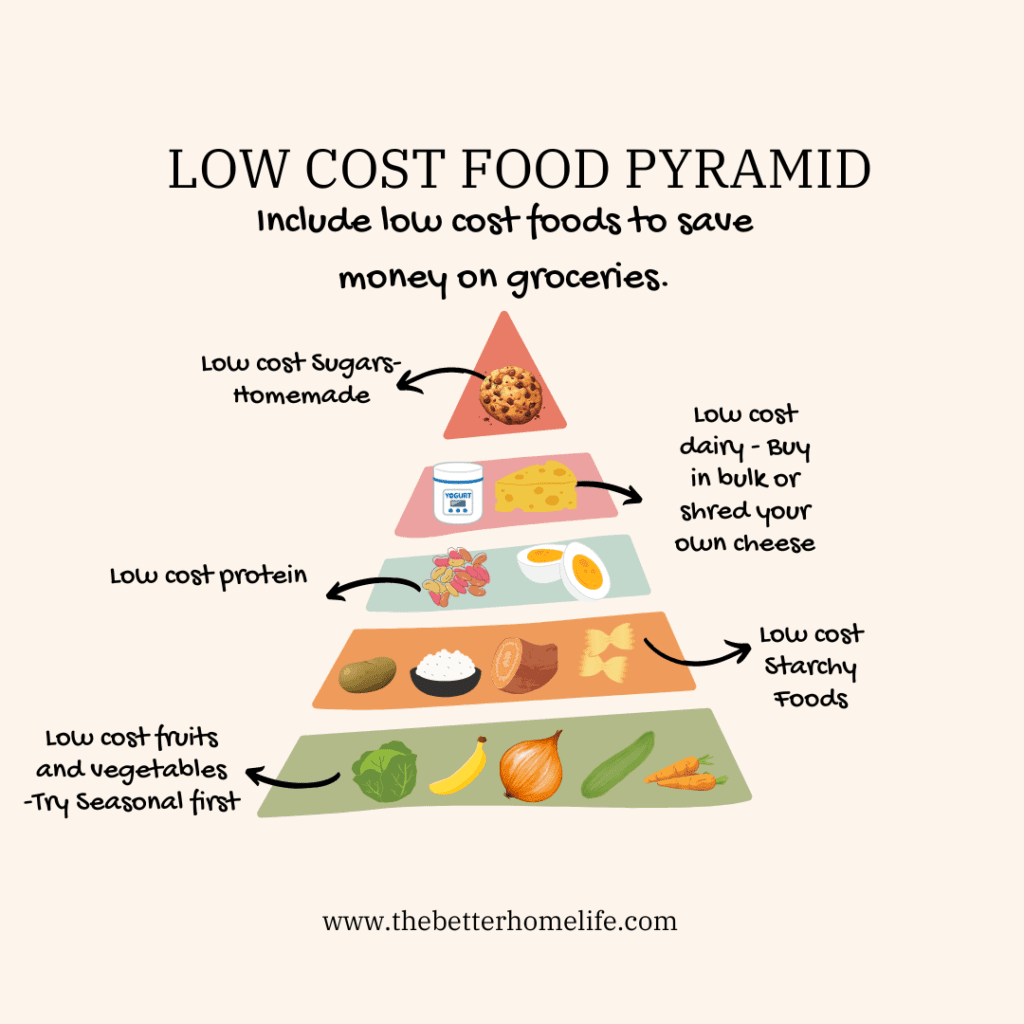
There are some foods that are budget friendly and can be used to feed your family for less. Here are some examples of low cost foods that can help you save money on groceries:
Low cost food #1, Potatoes
There are plenty of recipes that include potatoes. Soups and casseroles like Shepherd’s Pie. If you are trying to save on your grocery budget you can add a couple extra potatoes to these recipes to expand the number of portions. A baked potato can also be a very easy and inexpensive side to any meal.
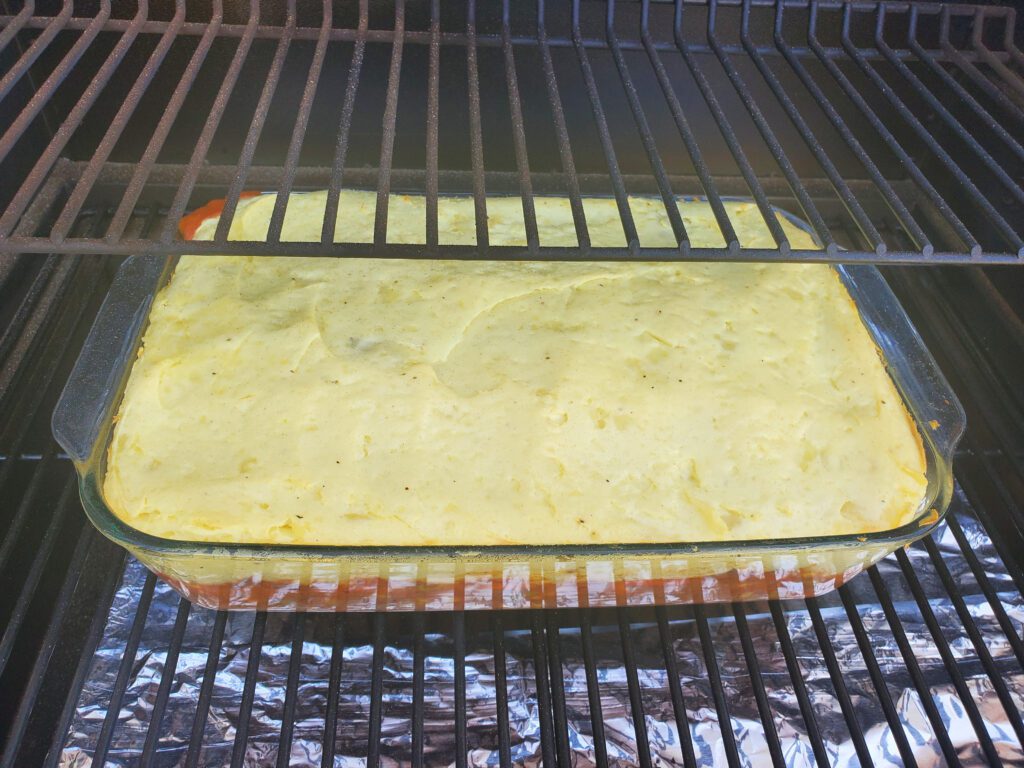
Find my Shepherd’s pie recipe here.
Low cost food #2, Pasta
Pasta. It is not difficult to find a sale on pasta. This ingredient can easily be added in excess to most recipes to expand your number of portions. It also makes an inexpensive side dish or salad.
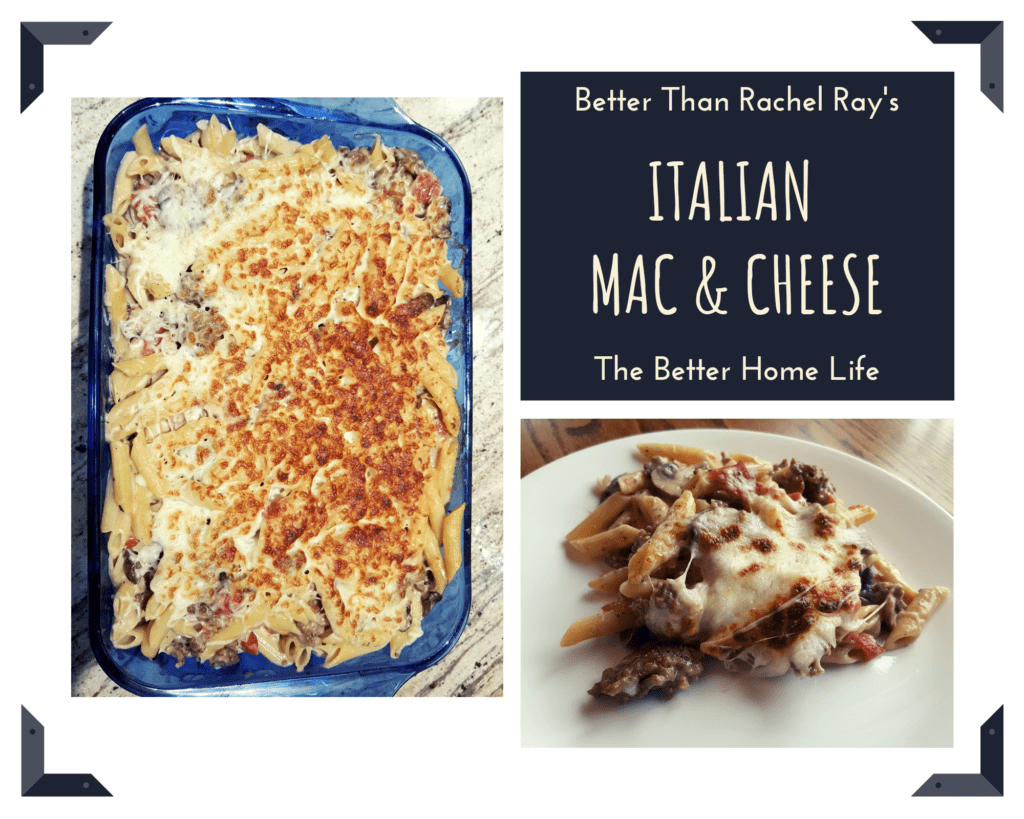
Click here, for my favorite pasta recipe.
Low cost food # 3, Zucchini
I stopped growing my own zucchini a few years ago because I noticed that I was having to turn down so much free zucchini from friends, family, and neighbors. I’m sure you have seen a pile of free zucchini on your breakroom table each summer. Just one plant provides more zucchini than most families can consume. Take the free zucchini, make bread or add it to your stir fry or just grill it up next time you make burgers. My favorite zucchini dish is zoodles! You will need to invest in a zoodle maker, but it is worth it to make a delicious pasta dishes with zucchini as noodles. We sauté onions and garlic in olive oil then add the zoodles to the pan. Sauté until warm then add capers and olives. Top with some shredded parmesan and you have a tasty meal or side dish, the bulk of which was free!
Low cost food #4, Eggs
Want to add some inexpensive protein to your meal? Consider adding eggs. I like to keep some hard boiled eggs in my fridge. They make a quick and easy inexpensive breakfast. They are also a great addition to fresh salads. You can also use eggs in fried rice.
Low cost food #5, Cabbage
This is a very inexpensive vegetable and it is so versatile. You can make coleslaw as an inexpensive side dish. Add it to salads, soups, or sandwiches. It can also be a meal itself. It has a very long shelf life, longer than lettuce so it can also help reduce food waste.
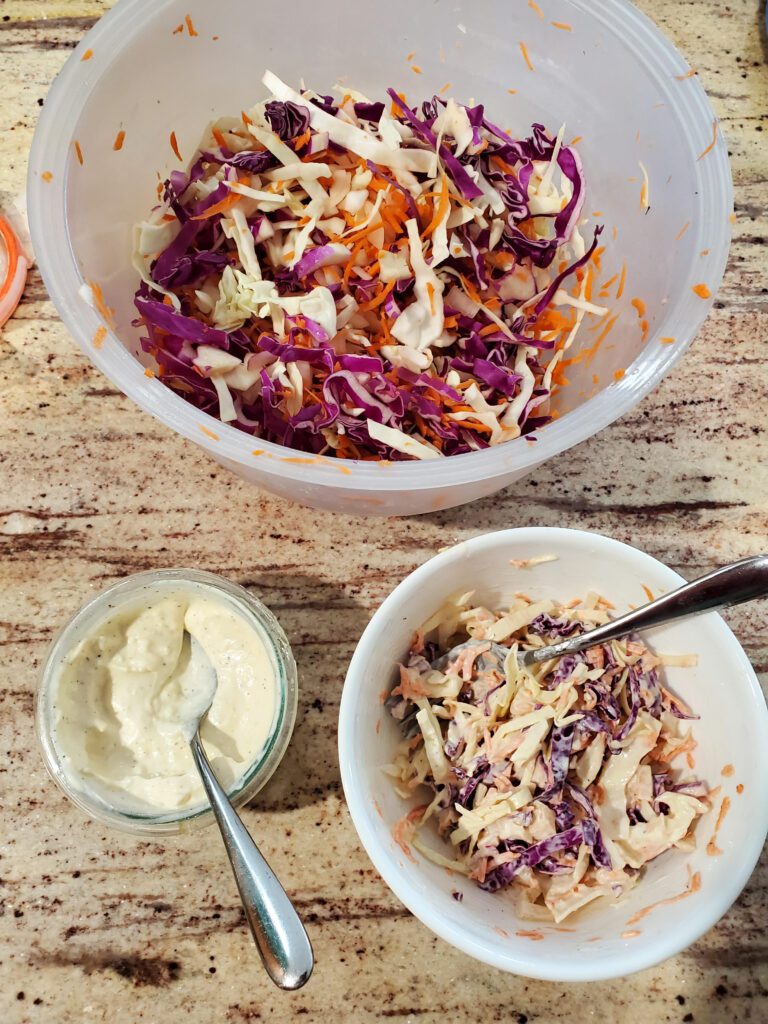
Low cost food #6, Beans
Add some beans to your meat. I used to add one can of beans to every one pound of ground beef when I made chili. I have found that I can add an extra can of bean per pound of beef and the chili is still delicious, and I get an extra serving. Here is my chili recipe. Try this tasty bean salad.
Low cost food #7, Rice
This is a very inexpensive ingredient that can be prepared as a meal or side dish. There is seemingly no end to the varieties of ways you can prepare rice. I love fried rice, Spanish rice, and Caribbean rice. You can add it to pretty much any soup and many casseroles.
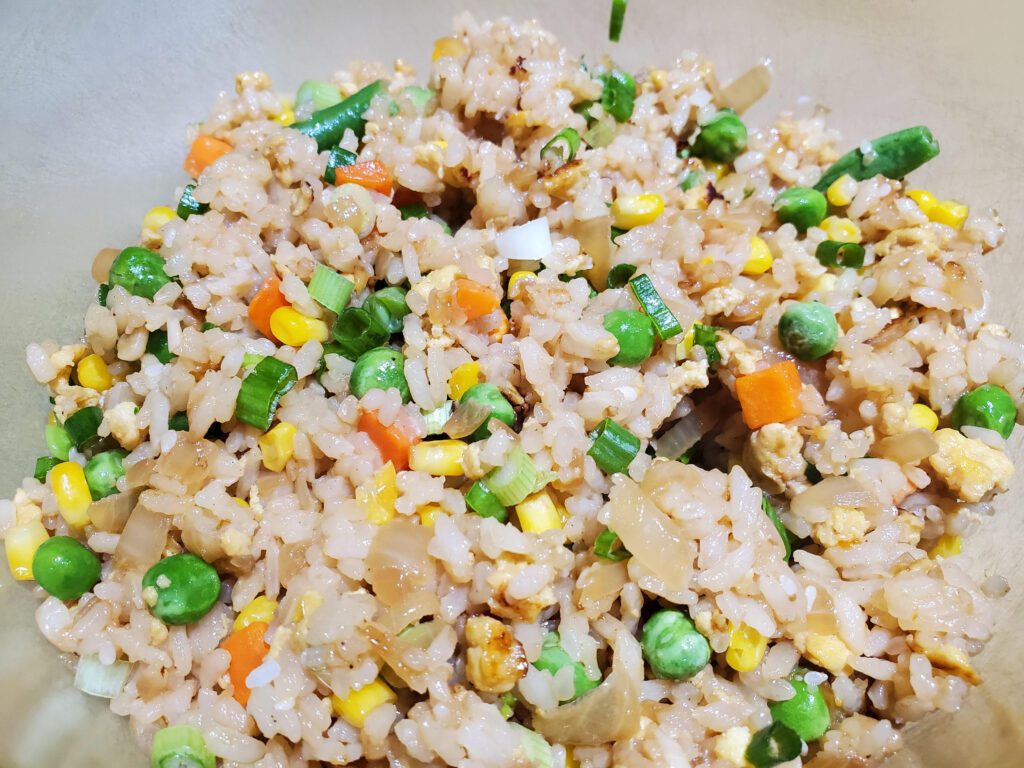
Low cost food #8, Onions
I’m not suggesting you eat a plain onion as a side dish, well maybe I am. It’s just that onions are very cheap and they are included in many recipes. If you double the onion you could add an extra serving to many dishes, plus make them healthier and more flavorful. If you are grilling, wrap and onion in some foil and throw it on the grill. Grilled onion is a delicious addition to pretty much any grilled meal.
More ways to save money
As an amazon associate, I earn from qualified purchases.

